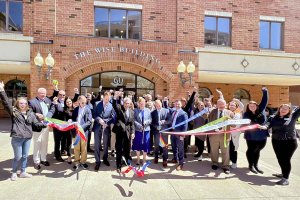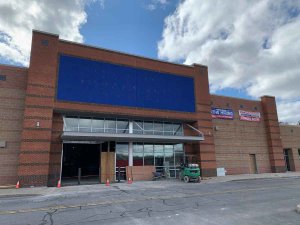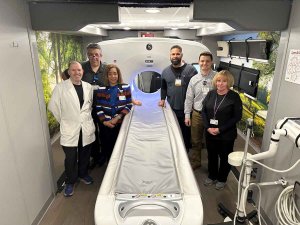
Made from Scratch: Deli Celebrates 20 Years
SARATOGA SPRINGS — Imagine two young men, 22 and 23 years old, riding their mountain bikes to a meeting that could make or break their dream of creating a local deli and pizzeria, and walking in with their caps still on backwards. That was 20 years ago, and the man who then owned the 132 Spring Street building, George Lega, tossed them out on their ears.
“He wouldn’t even talk to us,” remembered Spring Street Deli and Pizzeria co-owner, Brian Brumley. “Fortunately, our attorney was a good friend of Mr. Lega’s, so he convinced him to give us a second chance. We went back – without hats – and sat with him for four hours. We really hit it off, and he later sold the building to us and held the papers, a pretty big deal for a couple of kids. No one does that. If he were still with us today to see us hit 20 years, I’d say thank you. Thank you for giving us the opportunity. The guy was just incredible.”
Brumley and his childhood friend, deli co-owner Anthony Gargano, turned out to be a good bet. They had grown up in the restaurant business and five houses away from each other in Geyser Crest. After comparing notes, the two friends felt confident they could create a neighborhood eatery that people would enjoy regularly, so they reached out to a chef friend of theirs, Rob Cone, to help set them up at the Spring Street location.
“Rob said we’ll do everything fresh from scratch daily,” said Brumley. “Homemade soups, salsas, dressings, making a better product than just any deli with sliced meats and processed, canned food. We make it all homemade. We’ve added more items to the deli menu, and now, we’re expanding our catering menu. We purchased a wood fired pizza truck a few years ago, and that’s been growing. We’ve done weddings and such, but we’d like to do more events. The business is capable of doing any size party.”
With made from scratch offerings and a philosophy that a happy staff leads to happy customers, it’s no wonder the Spring Street Deli and Pizzeria has much to celebrate on its 20th anniversary.
“We’ve had so much support from family and friends over the years,” said Brumley. “They’ve helped us get where we are, and we can’t thank them enough.”
Gargano agrees and added, “You have to find yourself some great employees and we’ve done that. Our staff is incredible. A lot of them are lifelong friends. They work hard and make it look easy.”
Brumley said, “The best part is, through the years, the kids that worked for us still come back. Some will be home visiting from college and can’t wait to eat Spring Street instead of mom’s cooking. Parents will even buy favorites here and bring them to their kids in Boston or wherever because they miss it.”
Brumley and Gargano both attribute their success to that community support plus hard work, dedication, and providing great food at affordable prices. They feel the business has become more than just a deli; it’s a lifestyle, with loyal clientele that visit daily, a neighborhood place where customers and staff kid around with each other, often about sports. They even kid about the day they first opened.
“It was either the 5th or 7th of December in 1996,” said Brumley. “We both think it’s a different day. We probably could go look it up in the paperwork, but why not just make it an anniversary week? Or month?”
“It’s a playful atmosphere,” Gargano said. “Every day there’s something great that goes on. This past Thanksgiving, I was able to bring my daughter Chloe in to help me make platters, and she said it was one of the best times of her life, working with me.”
Brumley has two children, 6-year-old Nicholas and 5-year-old Sarah. Gargano and his wife, Kelly, have two daughters, 6-year-old Chloe and 3-year-old Cora.
“Chloe’s been saying she wants me to buy Little India next door so she can have a bakery next to her daddy’s deli,” said Gargano. “She can’t wait until she’s older to come work with me.”
For more information, to find out about the giveaways or the daily specials, visit the Spring Street Deli Facebook page or call 518-584-0994. For catering, ask for Meaghan Macfarland, the front of the house and catering manager, or Brumley or Gargano. Also visit www.springstreetdeli.net.
Five Decades: Saratoga Hospital’s 1st 50-year Employee
Lawsuit to be Brought in Legionnaires’ Death
New County GOP Chair Looks to “Keep Good Going”
Augie’s To-Go: Family-Style Italian for Pick Up in Saratoga
SARATOGA SPRINGS — Building a mouth-watering lasagna from scratch can be a real challenge for busy moms on-the-go, which is one reason why Augie Vitiello, chef and owner of popular mainstay Augie’s Family Style Italian Restaurant in Ballston Spa, is bringing his famous recipes to Saratoga Springs at a new take-out-only location coming in January.
“It’s so exciting to have Augie’s To Go moving into the neighborhood!” said Katrina Lucas of Saratoga Springs. “A quick weeknight meal just got so much easier. We can pick up the kids from after-school activities and pick up a fresh, amazing Italian dinner down the street.”
Augie’s Family Style Italian To Go will continue the Augie’s concept, with familiar menu items as well as prepared foods such as packaged homemade pastas and sauces. There will be homemade cannoli, seasonally flavored gelatos, and other desserts as well.
“You can come in and pick up a pound of fresh pasta and quart of marinara at your convenience,” said Vitiello. “Or you can call ahead to pick up a pan of eggplant parm, lasagna or meatballs and salad to have for company at home the next day. Fresh and hassle-free.”
Vitiello said he often heard from his restaurant customers that they wished he had a location in Saratoga Springs.
“We’re making life easier for our great customers in Saratoga so they don’t have to drive to Ballston Spa,” said Vitiello. “It’s a great Eastside location, across from the park where there’s lots of activity and a big population of families that want good, wholesome Italian food at a reasonable price just a phone call away. I see a niche for that, and I think it will do really well.”
Vitiello is taking over the former pizzeria at 223 Lake Avenue, just across from East Side Recreation Park, which has been empty for about a year.
“The landlord has been doing extensive renovations to the property,” said Vitiello, “and he’s excited having me join the property and bring it back to life. We’re anticipating an opening date in mid-January.”
Vitiello has originally opened his restaurant in Larchmont in 1990, and moved to Ballston Spa in 2004.
“It’s been great,” he said. “We’ve been growing all the time, constantly expanding what we do. We’ve expanded our footprint in the restaurant and now have two private dining rooms for private parties and banquets. It’s been pretty active and promising.”
Vitiello sees that success growing with this new take-out venue, which will be its own entity, with a phone number, website, and social media sites separate from the existing restaurant. For questions about Augie’s Family Style Italian To Go, email This email address is being protected from spambots. You need JavaScript enabled to view it.. For questions about Augie’s Family Style Italian Restaurant, located at 17 Low Street in Ballston Spa, call 518-884-8600 or visit AugiesRestaurant.com.
Small Shops: Founded on American Courage
SARATOGA COUNTY — There is something so quintessentially American about “bootstrapping,” and no one does it better than entrepreneurs and small business owners. Building a business from nothing more than an idea, sweat, and a prayer is a courageous undertaking. It’s something to think about the next time you walk into a small shop filled with hand-made soaps. Or dine at a local restaurant built from a grandparent’s secret recipe. Or even when you pay your neighbor’s kid to mow your lawn.
When a small business owner falls down, he has to pick himself up by his own bootstraps. There are no shareholders to lean on. No high-retainer attorneys or accountants to offer advice. An entrepreneur knows that each mistake could be her last. She knows if she doesn’t work today, she doesn’t get paid.
“When you have your own business, everything is personal. It’s your livelihood. For other people, it’s your job, but for us, it’s our lives, it’s what we do. Even when we aren’t here, we’re thinking about it, thinking about how to make it better,” said Maddy Zanetti, managing partner at Impressions of Saratoga and vice president of the Saratoga Springs Downtown Business Association. “The scariest part is believing in yourself, believing that you can run a store and be successful. You don’t have an employer to worry about that; it’s just you. Of course we couldn’t do it without all our employees, but as a business owner, you are putting yourself out there.”
The risks are so high; you wonder why anyone would even do it. Much as you might wonder why a farm boy in Utah would put his last dime into inventing an electronic camera tube (which led to the first television), or why hundreds of thousands of pioneers would pile whole families into covered wagons to build a new life – and new cities – across wild lands with nothing but the raw skills of brain and brawn.
Debi Gustafson, co-owner of Ye Olde Wishin’ Shoppe at 19 Low Street, Suite 2 (side entrance) in Ballston Spa, said, “The whole thing is a risk really. We had all this inventory and opened the store, and put our own savings in it. A big box store probably has investors and such. For us, it’s a family business, and we’re here every day working all the time. You put your whole life into it.”
Small business owners know they must master being flexible in uncertain times and changing circumstances, or close up shop. Gustafson said her family’s business began with her grandparents, and at one point they lost the shop they were renting because the building was being renovated. For a while, it was running out of her grandfather’s house and her grandma was selling items on eBay. Now they have a brick-and-mortar shop that Gustafson says has been doing better each year since it opened three years ago.
“We’ve evolved into vintage clothing and jewelry and vinyl records,” said Gustafson. “We also now have a lot of handmade local jewelry and other items, including a local photographer with vintage photos.”
The Small Business Saturday initiative that began in 2010 recognizes the tremendous economic contribution entrepreneurs and small business owners have made to the strength of this country. The annual event has proven that shopping small keeps local dollars in the community, positively affecting job creation and economic growth in locales across the U.S.
“I think this is our seventh Small Business Saturday,” said Zanetti. “We’ve done it every year they’ve had it, and it’s grown each year. We don’t offer discounts, but we have a raffle and food samplings and hot cider as a thank you to our customers. We have longer hours and give them the best service possible. We feel offering a discount on that day takes away from what Small Business Saturday is all about, supporting small businesses and giving back to the community.”
Small businesses offer more personalized service, more variety and unique items, and are very likely supporters of local nonprofits and other community initiatives. The majority of dollars spent in a small business stay in that locale. Shopping small on Small Business Saturday, and every day, is one way to say “thank you” to the innovators, artisans, service providers, and other pioneers who keep America working.
“I think it gets better every year,” said Gustafson. “We’re doing three little sales: the first one is buy one - get one half off on all our used vinyl; the second is 10 percent off new vinyl; and then 20 percent off storewide. Each year, more people are trying to shop local and support small businesses and do something different than just going to the mall. It’s cool to see more interest in Small Business Saturday.”
To learn more about Impressions of Saratoga, visit www.impressionssaratoga.com. To learn more about Ye Olde Wishin’ Shoppe, visit www.yeoldewishinshoppe.com. To learn more about Small Business Saturday, visit www.shopsmall.com.
Creating an Economic Supermoon: What to Expect in 2017
SARATOGA SPRINGS — The large meeting room at the Saratoga Springs City Center on Thursday, November 10 was crowded with businessmen, land use planners, economic developers and elected officials all wondering the same thing – what do the national election results mean for job creation and economic growth in Saratoga County in 2017? The answer is – it depends.
A supermoon effect of economic growth in any area of the country depends on a planetary alignment that reaches from the federal world of the new President-elect to all the local worlds of homeowners, mayors, town supervisors, and educational institutions, among others. Each group has its own internal shifts and changes, and each affects the other, so economic results can be diverse and unpredictable. Wrapping economic development arms around all those moving parts is a challenge, but one Marty Vanags, president of the Saratoga County Prosperity Partnership (the Partnership), is confident is manageable here in Saratoga County.
To explore how that can be done, the Partnership hosted a Saratoga County Prosperity Summit last week at the City Center, inviting experts such as Hugh Johnson, chairman and CIO of Hugh Johnson Advisors, LLC. Johnson’s successful management work of over a billion dollars in equity and investments for individuals and institutions has prompted his appearances on CNBC, Bloomberg News, NBC Nightly News, Fox Business, The News Hour, ABC World News Tonight, Wall Street Journal, and CBS Evening News. Johnson predicted fewer regulations and a good, solid year for Saratoga County in 2017, although the first half of a new Presidential term historically tends to be a bear market, and nationally, the economy will likely expand at a slow pace.
“The financial market environment will be positive but certainly not great,” said Johnson. “Everything is fine, but I’m saying, hang on, watch carefully and I hope we all collectively have a great 2017.”
The keynote speaker, Jeff Finkle, president, International Economic Development Council said workforce preparedness was one of the biggest issues facing economic developers in 2017. The national focus on a college degree has minimized the number of young people entering the skilled labor force, and developers are feeling that shortage across the country.
Malta Deputy Town Supervisor John Hartzell said that hearing several of the panelists’ concerns about workforce is something the county really needs to pay attention to.
“There’s a crucial need for a trained workforce to meet employer needs going forward in our county and region. I think our local secondary and postsecondary schools are aware of this, and we need to ratchet it up,” said Hartzell. “The other thing I took away from the summit is that economic development success tends to be regional, and that we’re going to have to reach across some traditional lines of counties and economic development agencies to succeed on a regional basis.”
The free summit at the City Center covered a variety of topics – from the state of economic development to case studies and community preparedness. Speakers also included: Matt Jones, Founder, The Jones Firm; Rocky Ferraro, Executive Director, Capital District Regional Planning Commission; Tom Kucharski, President and CEO, Invest Buffalo Niagara; Brian McMahon, Executive Director, New York State Economic Development Council; Congressman Paul Tonko, NY-20 and many others.
Kucharski has presided over a sea change in Buffalo’s economic growth and future prospects. His advice for 2017? “What I found in New York is everyone needs to put their swords down,” said Kucharski. “In this global economy you aren’t competing against each other, you’re competing against the world.”
Wilton Town Supervisor Art Johnson said he found Hugh Johnson’s remarks about the stock market and timing very informative, but the panelists’ comments on preparing a community for economic development hit home for him, validating that Wilton is doing something right.
“A lot of what they were talking about was how to get a project through the local level with some sense of predictability and reliability,” said Art Johnson. “I can relate to that very closely because some things they suggested, Wilton already has in place. We have a free pre-application process where a developer can meet with me, our planning board chair, and both the planning and building departments. We will give them the sense right away whether a project has any chance of going through, what hurdles they may face, and whether traffic or open space will be an issue. Or be honest with them that it’s not going to work. You’d find out upfront before investing in the project. This is helpful for both the town and the applicant.”
One of the areas of unpredictability discussed frequently was the reaction of homeowners and community members to development. Often, a development project will go through several hoops in the process before a public hearing is announced about the project, and the panelists said when a community is surprised or overextended, costs go up and the viability of the project goes down.
“To provide the predictability that is necessary, we need to invest in planning,” said Ferraro. “There’s a failure to do so in many of our municipalities. They use the excuse of regulations as planning, but there should be more than that. There’s an unfairness associated with using SEQR [State Environmental Quality Review] as the planning method. We should start before then. We need to bring the public in earlier in the process, so the developer doesn’t go through the whole SEQR process and then the town holds a public hearing and finds out the public is against the project. Find out the opposition first, be proactive.”
Ferraro gave an analogy of economic development’s impact on roads and other infrastructure. “It’s like this cup of water,” he said. “One project causes this much traffic, filling part of the cup, then the next one causes more, adding more to the cup, then a project comes in that would overflow the cup and that project is hit with all the costs of upgrading the road, even though the cause was the combination of all the previous projects.”
He suggested that rather than hit one developer with all that cost, and possibly lose the project and not get the road upgrades funded, local planning departments could calculate what the future needs of the road would be, and spread that cost across all projects coming in that will contribute to the road’s wear and tear.
“When it comes to the traffic studies as new large developments are being built, what happens is, until you hit the tipping point, there’s no need for additional traffic infrastructure,” said Saratoga Springs Supervisor Peter Martin. “And then when you find you do need it, the next person has to pay for everything. I agree, it’s important to think ahead to allocate those costs to all.”
Another suggestion was providing prospective homeowners with zoning maps, so they know exactly how close they are to land that could be developed commercially in future or other projects.
“It would be easier on everybody if folks, when they bought the property, would have accurate expectations about what will happen,” said Hartzell. “They think the forest or field next door is going to be there forever, and then it’s gone. One of the things we can do is make sure we have the community engaged in the land use planning process, so they have a good understanding of what’s going to happen around them in the community. Having homeowners participate in the process of deciding what will happen around them, even if it’s not exactly what they want, will at least give them the opportunity to participate, provide input, and be aware, which is important. We as town officials should make that happen.”
Finkle summed up the steps to a positive economic future well. He emphasized there needs to be an increase in blue collar labor, with more access to quality training; more concentration on local retention of existing businesses; more attraction and working with small businesses and entrepreneurs; more development project process predictability; and disaster preparedness.
“Ever since Katrina hit, disaster planning response and resiliency is a major issue,” said Finkle. “Even D.C. had an earthquake. Our infrastructure is in serious decline. Are you prepared?”
Vanags said the Prosperity Summit is just one of many conversations like this that will happen.
“I like to think of this as an ongoing dialogue," Vanags said. "The issue of consistency and predictability is most important, and the brokers and businesses want to know what happens during the process, the A-B-C’s that have to be followed, and they want to know if they can count on it. We’ll do that, that’s the role we play, coordinating between government and developers. We want to be the agent for streamlining these processes and I think many of our supervisors know and recognize that. I’m encouraged by the number of people who attended as well as who attended. It’s their investment that makes this kind of thing work. We plan to do a workforce roundtable in the first quarter of next year, so we’re reaching out to local employers for their input as we put that together.”
For more information about the Saratoga County Prosperity Partnership, visit saratogapartnership.org.
- economic development
- Saratoga County Prosperity Partnership
- Marty Vanags
- hugh johnson
- Peter Martin
- art johnson
- Saratoga County
- Planning Board
- Zoning
- supermoon
- International Economic Development Council
- hugh johnson advisors
- Town Supervisor John Hartzell
- Presidentelect
- Saratoga County Prosperity Summit
- jeff finkle
- skilled workforce
- Capital District Regional Planning Commission
- Rocky Ferraro
- Congressman Paul Tonko
- Tom Kucharski
- Invest Buffalo Niagara
- The Jones Firm
- New York State Economic Development Council
- Brian McMahon
- Wilton Town Supervisor
- malta town supervisor
- SEQR
- Saratoga Springs Supervisor Peter Martin




 How to resolve AdBlock issue?
How to resolve AdBlock issue? 


































